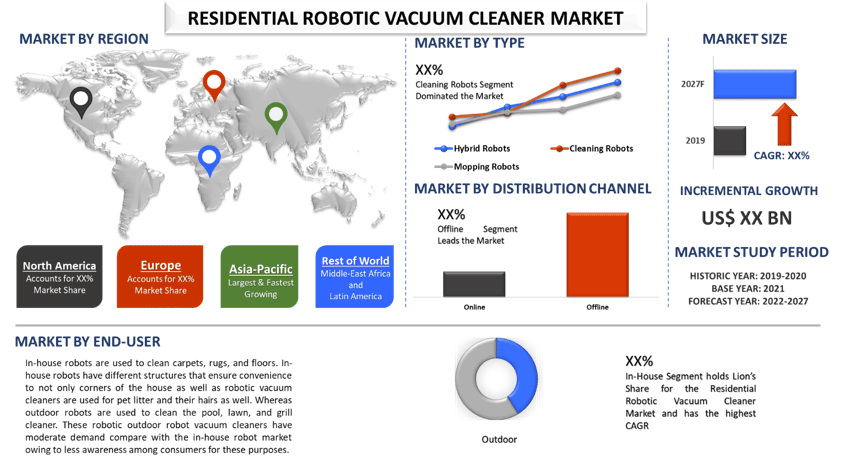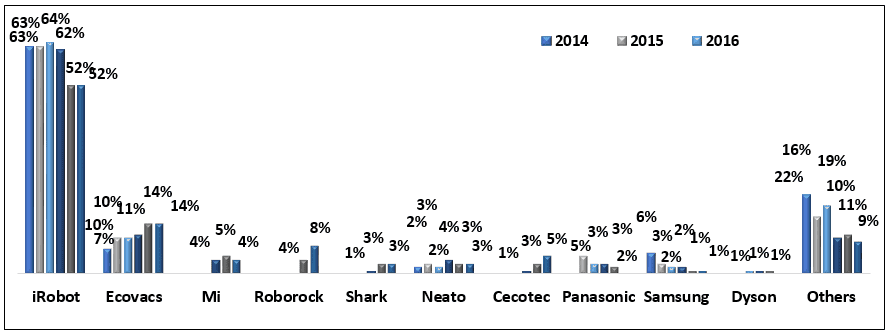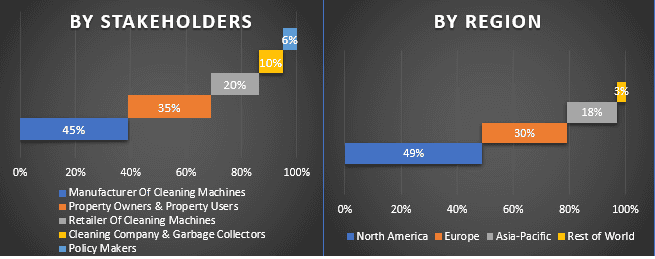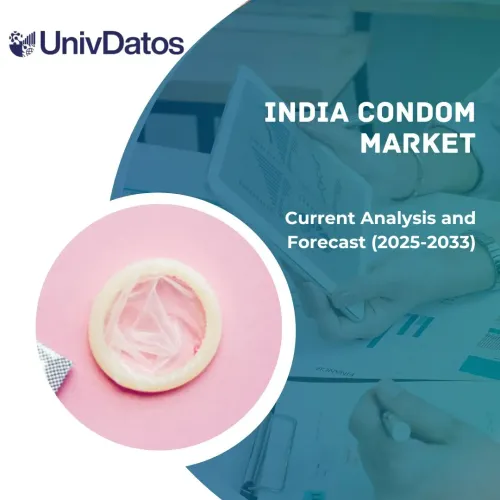- Home
- About Us
- Industry
- Services
- Reading
- Contact Us
Residential Robotic Vaccum Cleaner Market: Current Analysis and Forecast (2021-2027)
Emphasis on Type (Cleaning Robots, Hybrid Robots, Mopping Robots); Type of Charging (Manual Charging, Automatic Charging); Distribution Channel (Online, Offline); Operation (Self-driven, Remote-controlled); End-Use (Outdoor, Indoor); Region/Country

Residential Robotic Vacuum Cleaner generated revenue of ~US$ 2,628.3 million in 2020 and is expected to grow at a CAGR of more than 24% during the forecast period (2021-2027). A robotic vacuum cleaner, also known as Robovac or a Roomba is a floor cleaning system combined with sensors and robotic drivers and programmable controllers, and cleaning routines. The earliest applications of the robotic vacuum cleaners included remote control and self-drive mode with which the machine can clean autonomously without the need for human control. There are many brands producing these devices with various alterations. Some designs can reach tight corners whereas others have multiple cleaning features as well as the vacuuming feature (e.g., UV sterilization, mopping, etc.). The latest models are even equipped with artificial intelligence and deep learning to better map object identification and event-based cleaning. The key marketing strategies include low noise, autonomous cleaning, and ease of use. Additionally, other advantages of robotic vacuums include their smaller size and lighter weight as compared to the traditional vacuums. The key downside of robotic vacuums is that they are slower and takes an extended time to clean the area as they are also smaller in size. Also, they are a little more expensive.
This increase in demand for residential vacuum cleaners is due to the advancements in technologies, AI feature, voice assistance, and Wi-Fi connectivity. Companies are focusing on increasing features like the addition of UV sterilization during the pandemic to meet the changing customer demands. Additionally, the latest robotic cleaners are compatible with Alexa and the Google voice assistant. Other connectivity like smart home technology and IoT devices are opening new paths for robot manufacturers. For example, in December 2018, Neato Robotics launched Neato Zone Cleaning for the Botvac D7 Connected and No-Go Lines feature for Botvac D3 Connected with these consumers can highlight the area they want to be cleaned and create a no-go zone, respectively. This increases the flexibility of robotic cleaning.
Robotic Vacuum Cleaner Market Share According to Brand (%), 2014-2019

iRobot Corporation., Neato Robotics, Inc., Yujin Robot, Co., Ltd., Dyson Inc., Ecovacs Robotics, Inc., Hayward Industries, Inc., Philips Electronics N.V., Samsung Electronics Co., Ltd., Pentair plc., and Milagrow Business & Knowledge Solutions (Pvt.) Limited are some of the prominent players operating in the Residential Robotic Vacuum Cleaner market. Several M&As along with partnerships have been undertaken by these players to facilitate customers with hi-tech and innovative products/technologies.
Insights Presented in the Report
“Amongst Type, Cleaning Robots segment holds the major share”
Based on type, the residential robotic vacuum cleaner market is segmented into Cleaning Robots, Hybrid Robots, and Mopping Robots. Amongst type, the Cleaning Robots segment dominated the market in 2020. It is mainly owing to the inexpensive nature of the cleaning robot. In addition, factors such as the growing demand for smart & connected products coupled with the increasing importance of clean and hygienic homes, are driving the growth of this segment.
“Amongst Type of Charging, Manual Charging Segment holds the major share”
Based on the Type of Charging, the residential robotic vacuum cleaner market is segmented into Manual Charging and Automatic Charging. Amongst type of charging, the Manual Charging segment accounted for a major share in 2020. The price of a manual charging robotic vacuum cleaner is cheaper than an automatic robotic vacuum cleaner which in turn has escalated its adoption in the past few years and is expected to have considerable demand in the forecasted period as well.
“Amongst Distribution Channel, Offline Segment holds the major share”
Based on Distribution Channel, the residential robotic vacuum cleaner market is segmented into Online and Offline. The offline channel caters to extensive market share in the residential robotic vacuum cleaner market. It is mainly owing to the trust factor that has been gained by the service companies that have maintained the consumer preference towards the offline channel.
“Amongst Operation, Self-Driven segment holds the major share”
Based on operation, the residential robotic vacuum cleaner market is segmented into Self-driven and Remote-controlled. Amongst operation, the self-driven segment dominated the market in 2020. Self-driven robot vacuums have lasers, sensors, and Wi-Fi to help them navigate throughout the house. They require no outside control or input at all which makes them the more popular option. In 2017, 23% of all the vacuum cleaners sold were robotic. This number has dramatically increased in 2020 with the covid 19 pandemic due to the increasing hygiene frenzy.
“Amongst End-User, In-House Segment holds the major share”
Based on end-user, the residential robotic vacuum cleaner market is segmented into In-House and Outdoor. Amongst end-user, the in-house robots segment dominated the segment in 2020 and is expected to grow at a higher CAGR over the analyzed period. In-house robots are used to clean carpets, rugs, and floors. In-house, robots have different structures that ensure convenience to not only corners of the house as well as robotic vacuum cleaners are used for pet litter and their hairs as well. Whereas outdoor robots are used to clean pools, lawns, and grill cleaners.
“Asia-Pacific represents one of the largest markets of Residential Robotic Vacuum Cleaner market”
For a better understanding of the market dynamics of the Residential Robotic Vacuum Cleaner market, a detailed analysis was conducted for different regions across the globe including North America (the U.S, Canada, and the Rest of North America), Europe (Germany, France, Italy, United Kingdom, Spain, and Rest of Europe), Asia-Pacific (China, Japan, India, Australia, and Rest of APAC) and Rest of the World. North America dominated the market owing to the time saved with these robots.
Reasons to buy this report:
- The study includes market sizing and forecasting analysis validated by authenticated key industry experts
- The report presents a quick review of overall industry performance at one glance
- The report covers an in-depth analysis of prominent industry peers with a primary focus on key business financials, product portfolio, expansion strategies, and recent developments
- Detailed examination of drivers, restraints, key trends, and opportunities prevailing in the industry
- The study comprehensively covers the market across different segments
- Deep dive regional level analysis of the industry
Customization Options:
Residential Robotic Vacuum Cleaner market can further be customized as per the requirement or any other market segment. Besides this, UMI understands that you may have your own business needs, hence feel free to connect with us to get a report that completely suits your requirements.
Table of Content
Analyzing the historical market, estimation of the current market, and forecasting the future market of the Residential Robotic Vacuum Cleaner market were the three major steps undertaken to create and analyze the adoption of Residential Robotic Vacuum Cleaner in major regions globally. Exhaustive secondary research was conducted to collect the historical market numbers and estimate the current market size. Secondly, to validate these insights, numerous findings and assumptions were taken into consideration. Moreover, exhaustive primary interviews were also conducted, with industry experts across the value chain of the Residential Robotic Vacuum Cleaner market. Post assumption and validation of market numbers through primary interviews, we employed a top-down/bottom-up approach to forecasting the complete market size. Thereafter, market breakdown and data triangulation methods were adopted to estimate and analyze the market size of segments and sub-segments the industry pertains to. Detailed methodology is explained below:
Analysis of Historical Market Size
Step 1: In-Depth Study of Secondary Sources:
Detail secondary study was conducted to obtain the historical market size of the Residential Robotic Vacuum Cleaner through company internal sources such as annual report & financial statements, performance presentations, press releases, etc., and external sources including journals, news & articles, government publications, competitor publications, sector reports, third-party database, and other credible publications.
Step 2: Market Segmentation:
After obtaining the historical market size of the Residential Robotic Vacuum Cleaner market, we conducted a detailed secondary analysis to gather historical market insights and share for different segments & sub-segments for major regions. Major segments included in the report as Type, Type of Charging, Distribution Channel, Operation, and End-User. Further country-level analyses were conducted to evaluate the overall adoption of Residential Robotic Vacuum Cleaner in that region.
Step 3: Factor Analysis:
After acquiring the historical market size of different segments and sub-segments, we conducted a detailed factor analysis to estimate the current market size of Residential Robotic Vacuum Cleaner. Further, we conducted factor analysis using dependent and independent variables such as increasing labor costs and decreasing cost of robots. A thorough analysis was conducted for demand and supply-side scenarios considering top partnerships, merger and acquisition, business expansion, and product launches in the Residential Robotic Vacuum Cleaner sector across the globe.
Seek More Details About Research Methodology
Current Market Size Estimate & Forecast
Current Market Sizing: Based on actionable insights from the above 3 steps, we arrived at the current market size, key players in the Residential Robotic Vacuum Cleaner market, and market shares of the segments. All the required percentage shares split, and market breakdowns were determined using the above-mentioned secondary approach and were verified through primary interviews.
Estimation & Forecasting: For market estimation and forecast, weights were assigned to different factors including drivers & trends, restraints, and opportunities available for the stakeholders. After analyzing these factors, relevant forecasting techniques i.e., top-down/bottom-up approach was applied to arrive at the market forecast about 2027 for different segments and subsegments across the major markets globally. The research methodology adopted to estimate the market size encompasses:
- The industry’s market size, in terms of value (US$) and the adoption rate of Residential Robotic Vacuum Cleaner across the major markets domestically
- All percentage shares, splits, and breakdowns of market segments and sub-segments
- Key players in the Residential Robotic Vacuum Cleaner market in terms of products offered. Also, the growth strategies adopted by these players to compete in the fast-growing market
Market Size and Share Validation
Primary Research: In-depth interviews were conducted with the Key Opinion Leaders (KOLs) including Top Level Executives (CXO/VPs, Sales Head, Marketing Head, Operational Head, and Regional Head, Country Head, etc.) across major regions. Primary research findings were then summarized, and statistical analysis was performed to prove the stated hypothesis. Inputs from primary research were consolidated with secondary findings, hence turning information into actionable insights.
Split of Primary Participants in Different Regions

Market Engineering
Data triangulation technique was employed to complete the overall market estimation and to arrive at precise statistical numbers of each segment and sub-segment of the Residential Robotic Vacuum Cleaner market. Data was split into several segments & sub-segments post studying various parameters and trends in the areas of type and their type of the Residential Robotic Vacuum Cleaner market.
The main objective of the Residential Robotic Vacuum Cleaner Market Study
The current & future market trends of Residential Robotic Vacuum Cleaner were pinpointed in the study. Investors can gain strategic insights to base their discretion for investments from the qualitative and quantitative analysis performed in the study. Current and future market trends were determined the overall attractiveness of the market at a regional level, providing a platform for the industrial participant to exploit the untapped market to benefit as a first-mover advantage. Other quantitative goals of the studies include:
- Analyze the current and forecast market size of Residential Robotic Vacuum Cleaner in terms of value (US$). Also, analyze the current and forecast market size of different segments and sub-segments
- Segments in the study include areas of type and their subtypes
- Define and analysis of the regulatory framework for the Residential Robotic Vacuum Cleaner industry
- Analyze the value chain involved with the presence of various intermediaries, along with analyzing customer and competitor behaviors of the industry
- Analyze the current and forecast market size of the Residential Robotic Vacuum Cleaner market for the major region
- Major regions studied in the report include North America (the U.S, Canada, and Rest of North America), Europe (Germany, United Kingdom, France, Spain, Italy, and Rest of Europe), Asia-Pacific (China, Japan, India, Australia, and Others), and the Rest of the World
- Company profiles of the Residential Robotic Vacuum Cleaner market and the growth strategies adopted by the market players to sustain in the fast-growing market
- Deep dive regional level analysis of the industry
Related Reports
Customers who bought this item also bought










